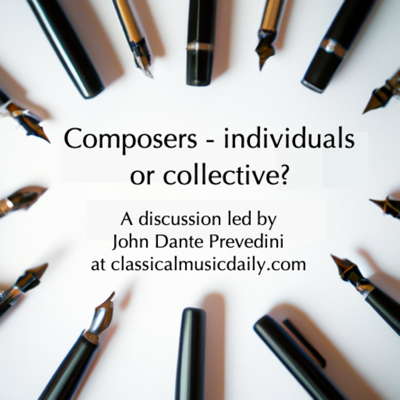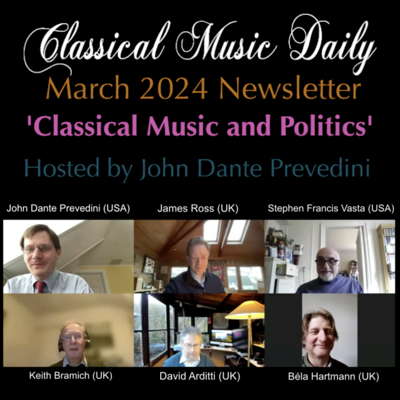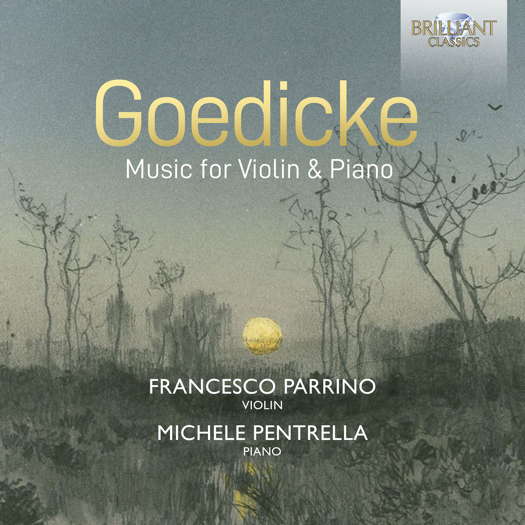- notes inégales
- Juan Orrego-Salas
- Gwendolyn Avril Coleridge-Taylor
- Daniel Pinkham
- spoken words
- Christopher Gibbons
- Yitzhak Levy
- Nigel Hess: A Christmas Overture
 DISCUSSION: John Dante Prevedini leads a discussion about Composers, individuals or collective?, including contributions from David Arditti, Halida Dinova, Robert McCarney and Jane Stanley.
DISCUSSION: John Dante Prevedini leads a discussion about Composers, individuals or collective?, including contributions from David Arditti, Halida Dinova, Robert McCarney and Jane Stanley.
 DISCUSSION: John Dante Prevedini leads a discussion about Classical Music and Politics, including contributions from Béla Hartmann and James Ross.
DISCUSSION: John Dante Prevedini leads a discussion about Classical Music and Politics, including contributions from Béla Hartmann and James Ross.

Well-crafted
Music by Alexander Goedicke for violin and piano, recommended by GEOFF PEARCE
'... a great disc of a sadly mostly overlooked fine composer.'
Before listening to this disc, I had only heard one work of Russian composer Alexander Goedicke (1877-1957) before - a trumpet concerto. As a composer these days he is often overlooked as his music is clearly in the nineteenth century tradition, but he spent most of his creative life in the twentieth century. This is a great pity. He wrote a considerable amount of music, including four operas, three symphonies, five concertos for various instruments, chamber works, piano and vocal music and it is well-crafted and would appeal to audiences if known. Goedicke was a first cousin of Nikolai Medtner who is much better known.
The first work on this disc is the First Violin Sonata, a youthful work written when the composer was twenty and is designated Opus 10. It is in three movements.
The first movement, sunny and melodic, reminds me somewhat of some of the Czech composers such as Dvořák or Suk. Whilst there are passionate sections, the work modulates and there are quite often many contrasting passages, the overall mood, at least in my mind, is happy and positive, and the writing for both instruments is assured, so I am surprised that this sonata does not feature on more programmes.
Listen — Goedicke: Allegro (Violin Sonata No 1 in A)
(track 1, 4:24-5:09) ℗ 2021 Brilliant Classics :
The second movement, marked Andante, is reflective, mildly wistful, and reveals that the composer has a melodic gift and is economical with his material, so that it does not become repetitive or boring.
Listen — Goedicke: Andante (Violin Sonata No 1 in A)
(track 2, 2:00-2:50) ℗ 2021 Brilliant Classics :
The finale, energetic and quick, is in the nature of a good-humoured dance. Like the other movements, this is beautifully written for both instruments and there are virtuosic passages, without it ever feeling like it is just an empty showcase. There is a slower section in the middle, as a contrast, which is reflective, before the work finishes with a flourish. I think any lover of violin music is going to appreciate this music.
Listen — Goedicke: Allegro molto e con Brio (Violin Sonata No 1 in A)
(track 3, 3:34-4:14) ℗ 2021 Brilliant Classics :
The second sonata follows, written much later, in the late 1940s, and designated Op 83. It is in four movements, quite different from the first sonata, and looks back to a much earlier age, to the late classical period of Beethoven, and it surprised me that such a work came from the mid-twentieth century.
The first movement is happy and very Beethovenesque, but could never be mistaken for him. It is very enjoyable, and there are touches here and there that make you realise this is from a later period. I think Goedecke wrote this out of admiration for the purity and balance of the earlier period.
Listen — Goedicke: Allegro (Violin Sonata No 2 in D)
(track 4, 3:48-4:35) ℗ 2021 Brilliant Classics :
The second movement, Largo, is heartfelt and solemn, and gently unfolds. It is a substantial movement of over nine minutes, and has some beautifully built up climaxes. I feel that this movement is the soul of this work, and it contains considerable variation in its development. The rhapsodic middle section is more romantic than the music around it.
Listen — Goedicke: Largo (Violin Sonata No 2 in D)
(track 5, 3:46-4:29) ℗ 2021 Brilliant Classics :
The third movement is a happy scherzo and provides plenty of opportunity for these two fine artists - violinist Francesco Parrino and pianist Michele Pentrella - to display their skills, and their playing is faultless.
Listen — Goedicke: Allegro Animato (Violin Sonata No 2 in D)
(track 6, 2:06-2:45) ℗ 2021 Brilliant Classics :
The finale is slightly slower and perhaps more 'classical', again, perhaps to balance the work from the middle two movements.
Listen — Goedicke: Allegro non Troppo (Violin Sonata No 2 in D)
(track 7, 2:15-2:57) ℗ 2021 Brilliant Classics :
The final music here is the '10 pieces of medium difficulty in first position'. This was published in 1948. These are short charming pieces lasting between one minute and just over three minutes in length and are of contrasting nature, and again hearkening back to a much earlier age without being pastiches. I know that these charming miniatures will appeal to any audience.
Listen — Goedicke: Aria (10 Pieces for Violin and Piano)
(track 12, 0:00-0:45) ℗ 2021 Brilliant Classics :
I am surprised by the lack of notes to accompany this disc. I think they are a must, and also I would like to know of these two artists. They are an admirable partnership, and obviously enjoy this excellent music. The piano is always clear and never overpowers, and the violinist has a wide range of expression and a flawless technique. I am full of admiration for them for presenting a great disc of a sadly mostly overlooked fine composer. You would have to be very jaded indeed to not enjoy this disc.
Copyright © 7 December 2021
Geoff Pearce,
Sydney, Australia

CD INFORMATION - GOEDICKE: MUSIC FOR VIOLIN & PIANO
CLASSICAL MUSIC ARTICLES ABOUT RUSSIA


